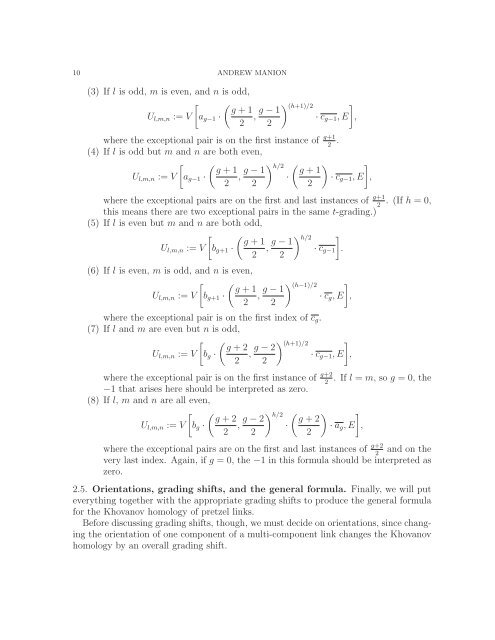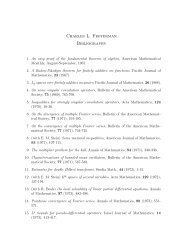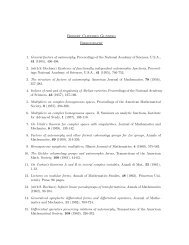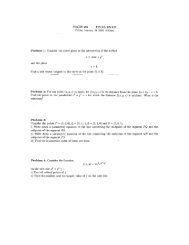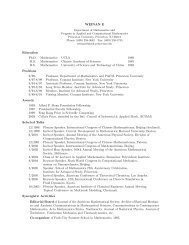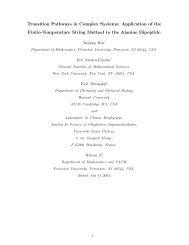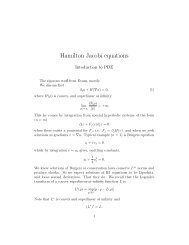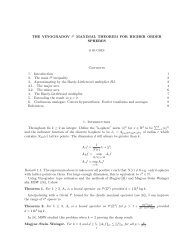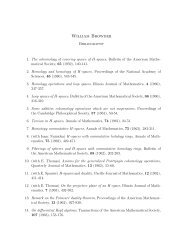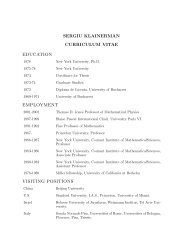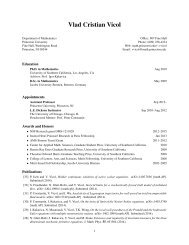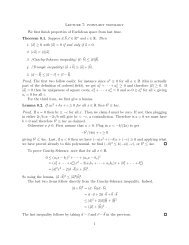The rational Khovanov homology of 3-strand pretzel links
The rational Khovanov homology of 3-strand pretzel links
The rational Khovanov homology of 3-strand pretzel links
Create successful ePaper yourself
Turn your PDF publications into a flip-book with our unique Google optimized e-Paper software.
10 ANDREW MANION<br />
(3) If l is odd, m is even, and n is odd,<br />
[<br />
U l,m,n := V a g−1 ·<br />
( g + 1<br />
2 , g − 1<br />
2<br />
) (h+1)/2<br />
· c g−1 ,E]<br />
,<br />
where the exceptional pair is on the first instance <strong>of</strong> g+1 . 2<br />
(4) If l is odd but m and n are both even,<br />
U l,m,n := V<br />
[<br />
a g−1 ·<br />
( g + 1<br />
2 , g − 1<br />
2<br />
) h/2 ( ) g + 1<br />
·<br />
2<br />
]<br />
· c g−1 ,E ,<br />
where the exceptional pairs are on the first and last instances <strong>of</strong> g+1 . (If h = 0,<br />
2<br />
this means there are two exceptional pairs in the same t-grading.)<br />
(5) If l is even but m and n are both odd,<br />
[ ( g + 1<br />
U l,m,n := V b g+1 ·<br />
2 , g − 1 ) h/2 ]<br />
· c g−1 .<br />
2<br />
(6) If l is even, m is odd, and n is even,<br />
[<br />
U l,m,n := V b g+1 ·<br />
( g + 1<br />
2 , g − 1<br />
2<br />
) (h−1)/2<br />
· c g ,E]<br />
,<br />
where the exceptional pair is on the first index <strong>of</strong> c g .<br />
(7) If l and m are even but n is odd,<br />
[ ( g + 2<br />
U l,m,n := V b g ·<br />
2 , g − 2 ) (h+1)/2<br />
· c g−1 ,E]<br />
,<br />
2<br />
where the exceptional pair is on the first instance <strong>of</strong> g+2 . If l = m, so g = 0, the<br />
2<br />
−1 that arises here should be interpreted as zero.<br />
(8) If l, m and n are all even,<br />
[ ( g + 2<br />
U l,m,n := V b g ·<br />
2 , g − 2 ) h/2 ( ) ] g + 2<br />
· · a g ,E ,<br />
2 2<br />
where the exceptional pairs are on the first and last instances <strong>of</strong> g+2<br />
2<br />
and on the<br />
very last index. Again, if g = 0, the −1 in this formula should be interpreted as<br />
zero.<br />
2.5. Orientations, grading shifts, and the general formula. Finally, we will put<br />
everything together with the appropriate grading shifts to produce the general formula<br />
for the <strong>Khovanov</strong> <strong>homology</strong> <strong>of</strong> <strong>pretzel</strong> <strong>links</strong>.<br />
Before discussing grading shifts, though, we must decide on orientations, since changing<br />
the orientation <strong>of</strong> one component <strong>of</strong> a multi-component link changes the <strong>Khovanov</strong><br />
<strong>homology</strong> by an overall grading shift.


